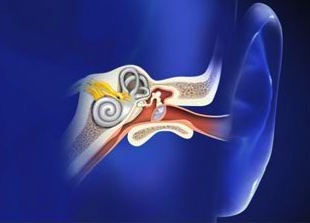This condition is a buildup of fluid pressure deep inside the ear.
Middle ear inflammation, common in infants and young children, can result in intense pain.
Anatomy
The middle ear is located between the tympanic membrane, commonly called the eardrum, and the cochlea and canals of the inner ear. The middle ear is connected to the nasal passage by a canal called the Eustachian tube. The Eustachian tube allows excess fluid to drain from the middle ear, and also helps equalize pressure between the middle ear and the atmosphere.
Inflamation
When the middle ear becomes inflamed, pus and fluid may fail to drain properly and may instead become trapped behind the eardrum. This buildup of fluid pressure results in pain and discomfort.
Causes
Inflammation of the middle ear can be caused by allergic reaction, infection, or a blockage of the Eustachian tube. A blockage may result from swollen tonsils or adenoids, or it may occur because of the structural anatomy of the skull.
Symptoms
Symptoms typically include severe pain and muffled hearing. Other symptoms may include irritability, headache, nausea, a change in sleeping patterns, a change in appetite, and difficulty speaking
Rupture
In some cases, the pressure buildup becomes so great that the eardrum ruptures. This bursting allows fluid and pus to drain out of the ear, relieving pain and pressure. In most cases, the eardrum will heal on its own after a rupture within a few months. But in some cases, this membrane may need to be repaired.
Treatment Options
Treatment for inflammation of the middle ear may vary depending on the cause. Options may include antibiotics, allergy medications, removal of the tonsils or adenoids, and the insertion of tubes in the eardrums to allow fluid to drain out of the ear.
Your healthcare provider can create a care plan that is right for your needs.



